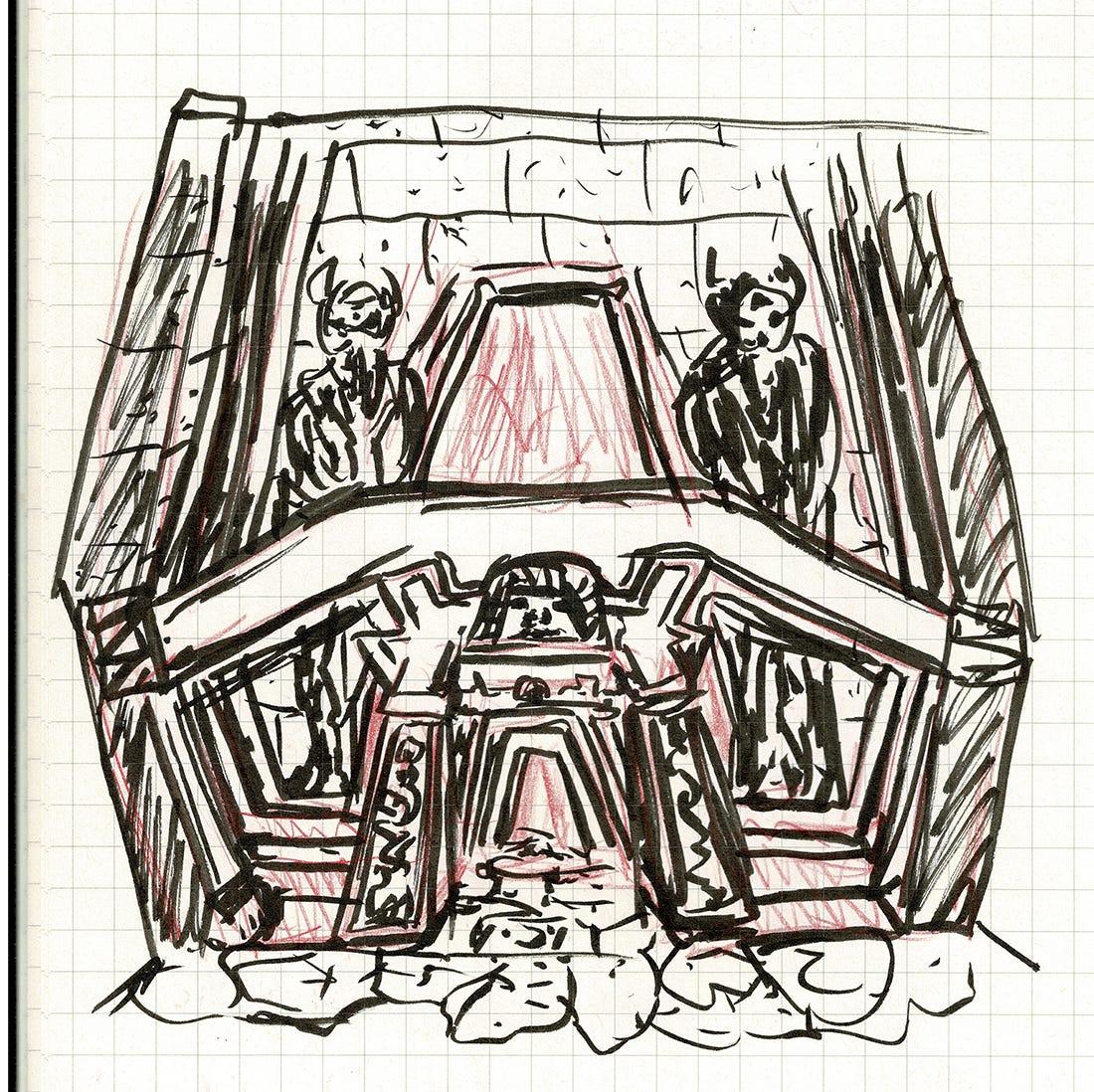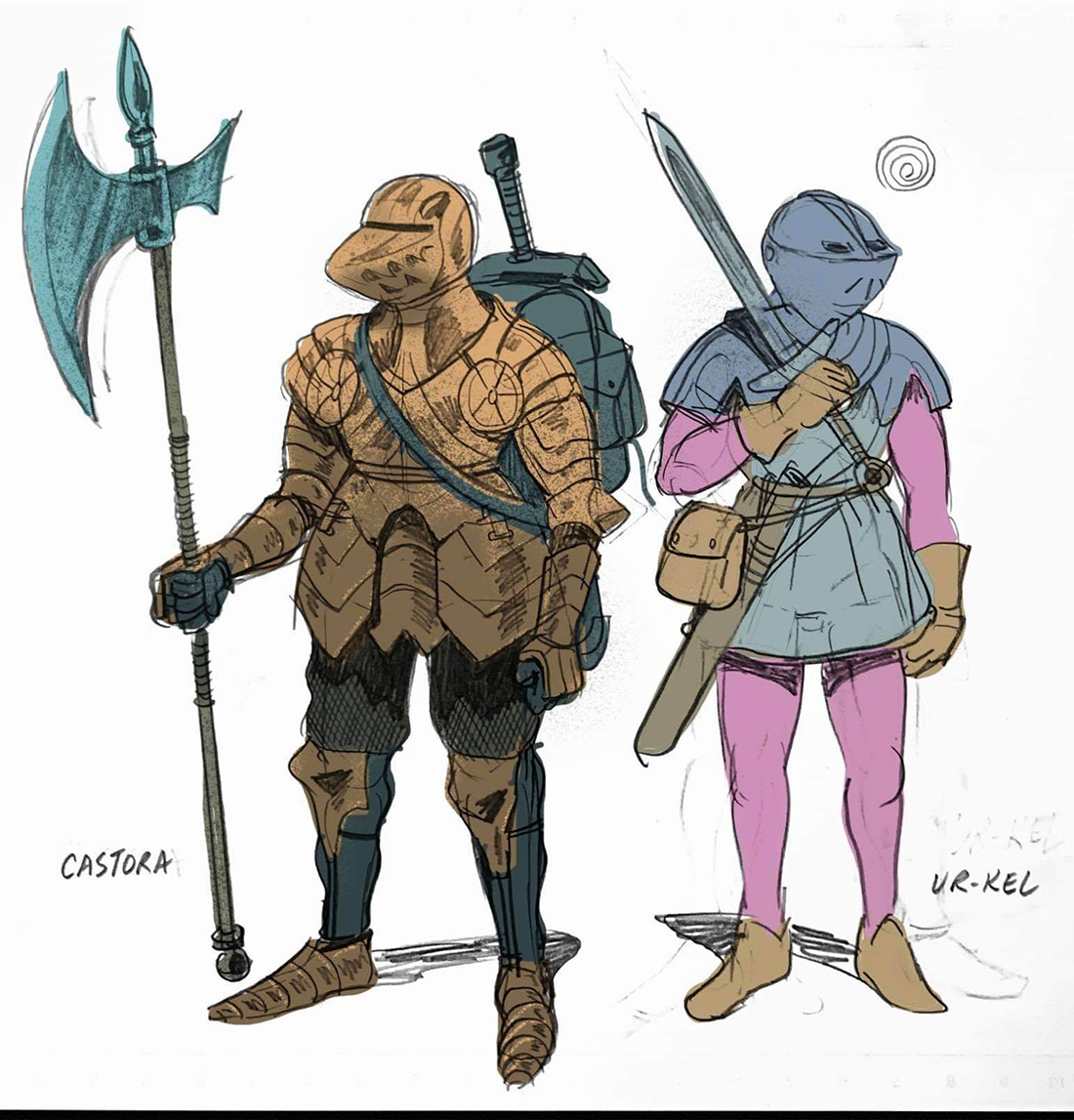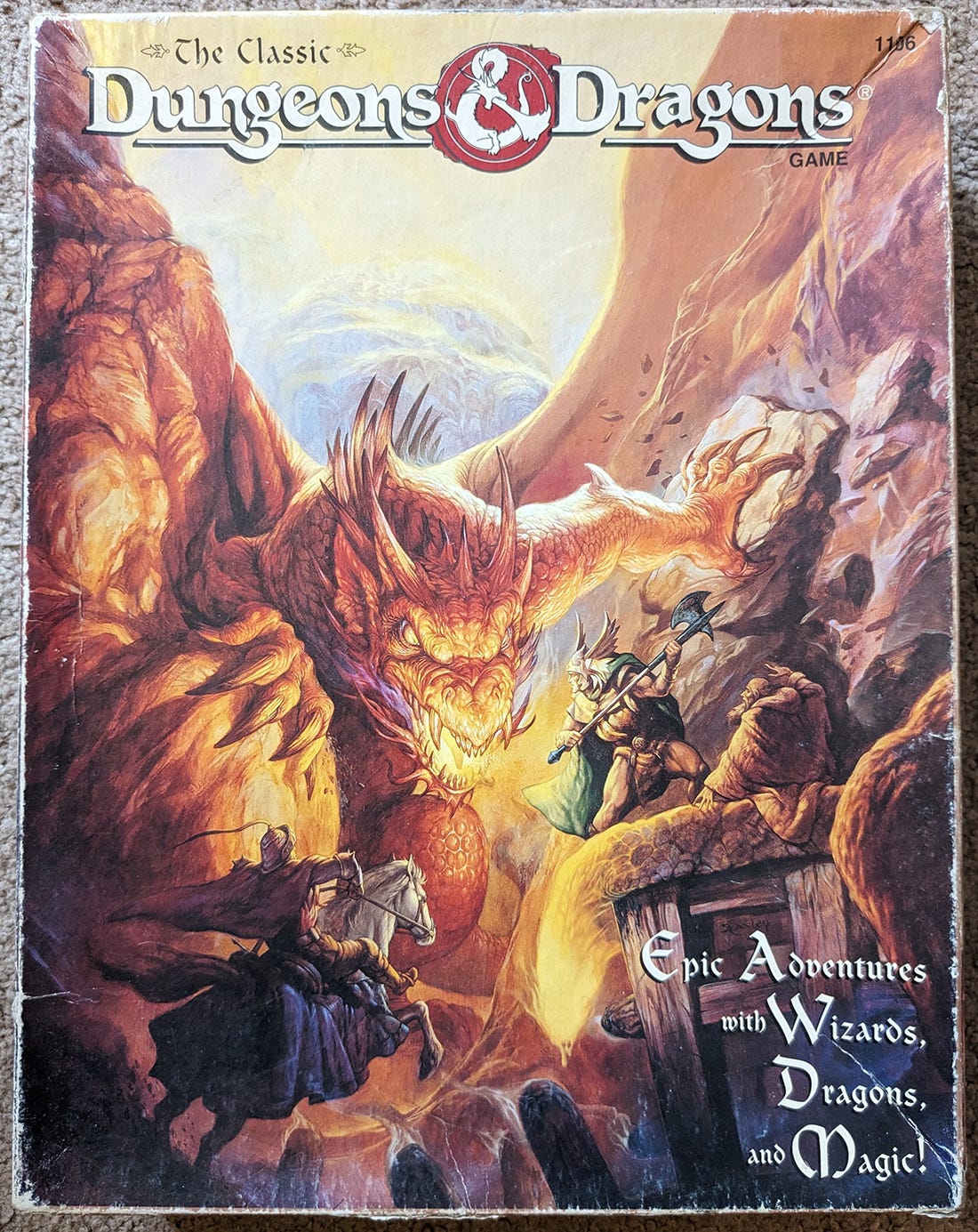Last time, I promised you all a newsletter installment on three things: scans unused from my last post, a look at a zine Ben L. wrote that is key to my campaign, and a reading recommendation I undertook from Skullboy (aka Better Legends). Well, things don’t work out as expected. Not only is this true about this newsletter but it is also the case in my home campaign, the Twilight Age.
In this dying earth megadungeon campaign, the unexpected is currently forcing me to confront some serious issues around time and player choice. Many of you will be familiar with the much maligned quote1 from the AD&D Dungeon Masters Guide from Gary Gygax that is generally cited as approximating something like “strict time keeping is necessary for a meaningful campaign”. Arguments, put downs, and defenses of this piece of advice seem so rote that I am loathed to even bring it up. In my megadungeon game, though, this maxim is actually pretty important more often than not. When running assorted parties made of different configurations of a dozen-to-two-dozen players through the same shared environment, it is important to know when different characters are where as well as how they changed those environments.
To manage this, I generally stick to two rules: 1.) every session begins and ends outside the dungeon and 2.) time passes in real time outside of a gaming session (though, surprisingly, the passage of time in session is often shockingly close to the length of a session). After a real rough period where timelines broke down as two groups were out adventuring in the greater campaign world for months will the remaining characters explored the megadungeon, I really strived to maintain this approach. I generally only loosened it when PCs were in other planes where time moves differently. Lately, though, this has been breaking down again. I have allowed stays in a few safe places in the vast subterranean jungle that is Level 4 of the dungeon. This has really caused some headaches around where characters exist along assorted timelines and how these timelines interact. It also swallows up time between player activity and events with fixed spots in the timeline like holidays. Currently, the most important issue on this front has been the collision of isolated slowed down timelines with time-sensitive campaign elements while real world constraints limit my flexability as a DM.

Two time-sensitive major campaign elements are currently at play in my campaign. One is a extradimensional dungeon called the Black Pyramid. The other is a tournament called the Castora Cup. The Black Pyramid (inspired by an unrealized adventure hook from Ben L.’s Wishery Campaign) has been teased as an adventure site set to materialize on the main plane the campaign for a year. The location’s window of visitation was established as from the super moon we had in late August to the Harvest Moon in September. Meanwhile, there is the impending Castora Cup tournament organized by an fellowship of monster hunting knights called the Order of the Dragon. The Order of the Dragon stages important events around the Hunter’s Moon. A player has one long simmering mission effecting the functionality of his PC that he wanted to fulfill before joining an expedition to the Black Pyramid. A change in his work schedule and a wedding for another player this week means that I cannot fulfill this mission and started an party on the Black Pyramid in the allotted timeframe. This character can’t visit the Black Pyramid without either delaying the departure of the nomadic extradimensional structure or making the timeline elastic again.

Why does this matter and how does the Castora Cup play into it? As to the former, I historically allow DM armor or flexibility when external matters from my life create a situation when a player’s interest to go unfilled. A previous example of this would be a party having to delay the retrieval of a dragon’s hoard because I have to celebrate my birthday with my family. It didn’t seem very fair to the party to have other players swoop in to take the treasure, to have another monster take up residence with the hoard, or some other complication just because my life would delay their ability to follow through on their plans. In this current case, however, I don’t feel like I can allow for this grace with the rules of time in the campaign.
One reason I feel this way is looking at the campaign at the macroscale. I want the players to grow to expect that every year with the arrival of the Hunter’s Moon in our world, that the Order of the Dragon has feasts and tourneys with the arrival of the same moon in the Twilight Age. I strongly feel that such kind of rhythms help make the campaign setting feel like a real place where time passes. If I push back the Castora Cup to allow for delayed entry into the Black Pyramid, that means that I lose that anchoring point.
The other reason is DM work load. I don’t want to be figuring out and fine tuning running the Black Pyramid while I am designing the challenge for the Castora Cup. I just don’t have the capacity for it. I know I could just force players to miss out on the Black Pyramid as a way to manage things but it has been teased for so long that just dropping it now doesn’t feel very satisfying. I haven’t figured out a solution to this dilema yet. I thought sharing it provided a look into the time management issues that can occur in this kind of campaign.
Downtime in Zyan
Last time, I mentioned that host of the Into the Megadungeon podcast (which I was on), creator of the zine Through Ultan’s Door, player in my Twilight Age Campaign, and most importantly a true pal of mine Ben L. is running a sale on his zines until October 1st. How is this relevant to this newsletter? The answer is this specific installment:
Downtime in Zyan written by Ben and illustrated by Evelyn Moreau presents a fine tuning of a downtime system Ben had been posting on his blog Mazirian’s Garden. This zine is probably the most essential document to my Twilight Age campaign outside of my dungeon keys. When I approached developing my current campaign, I knew I wanted to have sessions focus on exploration and have life in the nearby settlement of Orm play out through some sort of collection of procedural systems. A megadungeon campaign I had played in previously had hints of such downtime phases. I experienced similar kinds of phases as a player in Ben’s Wishery campaign2. When I started to put together my own collection of downtime systems, I took my own take on the now modern classic of a carousing table along with a thieving system developed by Skullboy, and the magical research system of B/X & Old School Essentials. As I worked on this, Ben started posting his downtime system which I quickly incorporated piecemeal into ,y own collection of potential activities.
Refined for publication within the pages of Downtime In Zyan, Ben’s system covers activities such as Building an Institution, Cultivating a Relationship, Gather Intelligence, Learning a Skill, Martial Training, Research, Revelry, Spellcraft, Splendid Artifacts, and Spiritual Exercises. These core activities provide a robust system that covers most of what players want to tackle in their time away from adventuring. My own players have used them for such things as researching the stacks of a library the built from texts plundered from the megadungeon, establishing Orm’s primary shop for adventuring gear and jars, turning defeated dragons into armor, and training each other in the techniques of dueling.
The real gift of Ben’s work in these zines is not any one specific activities as a rule but by giving a sampling of activities that allows readers to a build a technique to use in almost any situation. Ben’s rules centered around spending a turn in downtime to make a 2d6 roll (with relevant modifiers) that provides varying levels of success. Based on this level of success, the player is given the results of their failure or success (sometimes aided by a second roll of another die). The underlining mechanics are so robust and easy to grasp. Using Ben’s rules as a guide, you can ad lib one off downtime situations with ease. They also provide great inspiration to create new regular activities using the same mechanics like I did for selling off valuable dungeon loot to interested buyers.
Having a vibrant downtime system in my own campaign has really allowed the setting to come alive and for PCs to leave their stamp on the world while keeping session time spent away from adventuring down to a minimum. The subject of this approach to downtime activities is something I had planned on talking about at a later date. With Ben selling a limited supply of the Downtime In Zyan on its own (he also has a supply included in a collection of all of the issue of Through Ultan’s Door), I thought I should mention this key tool for my own Dungeon Mastering while he still has physical copies to sell. The .pdf isn’t going anywhere but if you are like me and have a hard time really pulling info from digital reads then grab your copy while you can.
Skullboy Opens An Old Box
I have mentioned Skullboy a few times in this newsletter. That reading recommendation of his I mentioned earlier is getting pushed back to a future post. Until then, I did want to point you all to his last blog post at his site, Better Legends:
In it, he cracks open a old D&D box not filled with the booklets and materials the set once contained but with ephemera from years of him playing D&D. You can get a glimpse of old character sheets, character drawings, saved published maps made by other folks, materials he made for campaigns he ran, and more. I feel like the way the post allows you to follow his path through the hobby via actual keepsakes has a lot in common with the spirit of this newsletter.
Alright then. Next time, I promise we will look at those scans I made of stuff from the development of What Fools These Adventurers Be and finally dig into Skullboy’s reading recommendation of Delicious in Dungeon. See you all then!
People love to attribute general memories of the phrasing of this quote as what was said. A quick internet search will show the variances in this passage that happen. I love the kind of folk knowledge this places the idea in. I also don’t think the specifics matter here so I am not going to go pull the exact quote.
I like to think that the conspiracy-theory fueled research my PCs Ernis the Magic-User and Mia the Thief did into treaties of Zyan were one of the elements that pushed Ben to really refine this system. Ben was really able to center this kind of research in the game to a level I have yet to succeed at with any downtimes in my campaign.




Speaking of management, I also wonder whether you can expand –perhaps on a future post?– on the nitty gritty of scheduling and organizing sessions with a large pool of players like yours.
Your podcast interview with Ben L. touched on this subject briefly. I think it would be super useful for aspiring open table megadungeon GMs (like me!) to learn more about your tricks and tips of organizing sessions.
A common GM complaint about the now traditional approach to D&D campaigns –the dedicated table of 4-5 players expected to show up regularly for months or years– is how frustrating scheduling can be. And how often it leads to the death of campaigns. This problem supposedly finds and antidote in the open table megadungeon campaign. But there is still some scheduling to do... How do you schedule and organize sessions with players?
I would love if you could get really specific. I mean, the questions I have in mind include:
- Do you invite all your players to play at a specific day and time, and then play with those who commit to that session? Or do you pre-select players that you think may “glue” together and invite them (I think you described an approach like this in the interview)? If you do, are they still one-off groups? Or they become stable mini-groups that always meet independently from others (in other words, how promiscuous, so to speak, are each session's group?
- How do you invite with players? Email? Discord? Calls? And do players have communication channels between sessions? Discord? General Discord chat, or small-group specific chars?
- Do you set the day and time? Or do you negotiate the day and time with players? Do you use scheduling tools like Doodle?
- How have been your experiences letting players themselves organize sessions (West Marches style)? I think you mentioned that hasn’t work so well, but why?
- And has your approach for scheduling and inviting players changed over time as the campaign progresses?
I hope that's not too specific for this substack's aim! Perhaps Ben L. should have a whole episode on Scheduling the Megadungeon... Anyway, thanks again for your great posts!
I’m enjoying this post series very much. It is helping me set up my own open table megadungeon campaign. Thank you sir!
I would like to ask you some questions about the two time management rules and something you had said on a comment to the Sept 14 post: “Neither What Fools or Twilight Age are 100% in the megadungeon. Twilight Age has had sessions as afield as to neighboring city-states, the fey realm, and the moon.”
How do you handle the end and beginning of a session that doesn’t happen in the megadungeon, e.g., in a neighboring city-state or wilderness? Do you still enforce some form of closure (something like the ending outside the dungeon rule)? How does this look like, narratively speaking? If a session ends with a group of PCs exploring a city-state, and then a week passes (in real time) before the players meet again, does that mean that the PCs stayed in the city-state doing downtime activities for a week (in the fictional time)? What if they are exploring the wilderness? Camping for a week? Or are they expected to come back to the base of operations (a small town?) at the end of the session, even if it happened in a city or the wilderness?